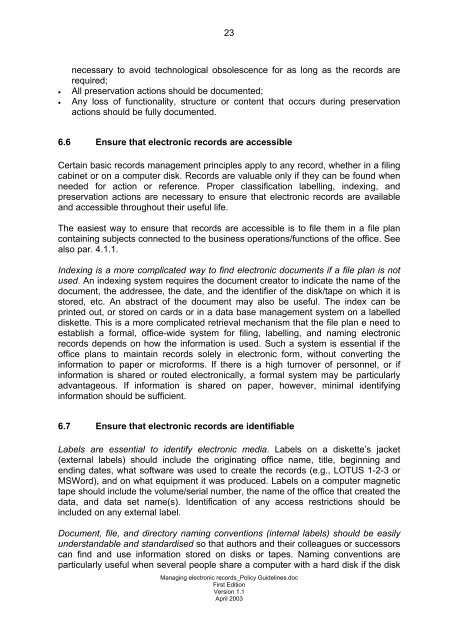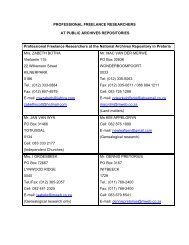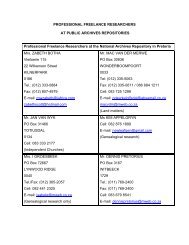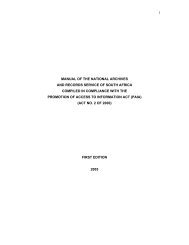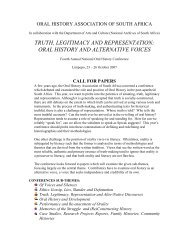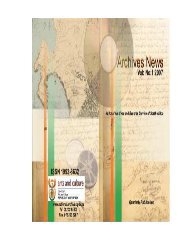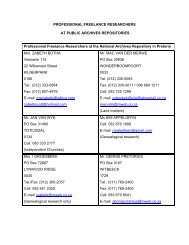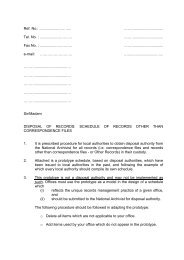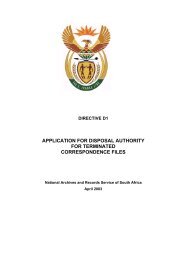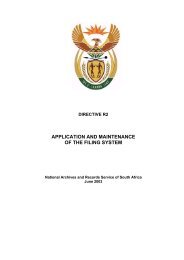managing electronic records in governmental bodies - National ...
managing electronic records in governmental bodies - National ...
managing electronic records in governmental bodies - National ...
Create successful ePaper yourself
Turn your PDF publications into a flip-book with our unique Google optimized e-Paper software.
23<br />
necessary to avoid technological obsolescence for as long as the <strong>records</strong> are<br />
required;<br />
• All preservation actions should be documented;<br />
• Any loss of functionality, structure or content that occurs dur<strong>in</strong>g preservation<br />
actions should be fully documented.<br />
6.6 Ensure that <strong>electronic</strong> <strong>records</strong> are accessible<br />
Certa<strong>in</strong> basic <strong>records</strong> management pr<strong>in</strong>ciples apply to any record, whether <strong>in</strong> a fil<strong>in</strong>g<br />
cab<strong>in</strong>et or on a computer disk. Records are valuable only if they can be found when<br />
needed for action or reference. Proper classification labell<strong>in</strong>g, <strong>in</strong>dex<strong>in</strong>g, and<br />
preservation actions are necessary to ensure that <strong>electronic</strong> <strong>records</strong> are available<br />
and accessible throughout their useful life.<br />
The easiest way to ensure that <strong>records</strong> are accessible is to file them <strong>in</strong> a file plan<br />
conta<strong>in</strong><strong>in</strong>g subjects connected to the bus<strong>in</strong>ess operations/functions of the office. See<br />
also par. 4.1.1.<br />
Index<strong>in</strong>g is a more complicated way to f<strong>in</strong>d <strong>electronic</strong> documents if a file plan is not<br />
used. An <strong>in</strong>dex<strong>in</strong>g system requires the document creator to <strong>in</strong>dicate the name of the<br />
document, the addressee, the date, and the identifier of the disk/tape on which it is<br />
stored, etc. An abstract of the document may also be useful. The <strong>in</strong>dex can be<br />
pr<strong>in</strong>ted out, or stored on cards or <strong>in</strong> a data base management system on a labelled<br />
diskette. This is a more complicated retrieval mechanism that the file plan e need to<br />
establish a formal, office-wide system for fil<strong>in</strong>g, labell<strong>in</strong>g, and nam<strong>in</strong>g <strong>electronic</strong><br />
<strong>records</strong> depends on how the <strong>in</strong>formation is used. Such a system is essential if the<br />
office plans to ma<strong>in</strong>ta<strong>in</strong> <strong>records</strong> solely <strong>in</strong> <strong>electronic</strong> form, without convert<strong>in</strong>g the<br />
<strong>in</strong>formation to paper or microforms. If there is a high turnover of personnel, or if<br />
<strong>in</strong>formation is shared or routed <strong>electronic</strong>ally, a formal system may be particularly<br />
advantageous. If <strong>in</strong>formation is shared on paper, however, m<strong>in</strong>imal identify<strong>in</strong>g<br />
<strong>in</strong>formation should be sufficient.<br />
6.7 Ensure that <strong>electronic</strong> <strong>records</strong> are identifiable<br />
Labels are essential to identify <strong>electronic</strong> media. Labels on a diskette’s jacket<br />
(external labels) should <strong>in</strong>clude the orig<strong>in</strong>at<strong>in</strong>g office name, title, beg<strong>in</strong>n<strong>in</strong>g and<br />
end<strong>in</strong>g dates, what software was used to create the <strong>records</strong> (e.g., LOTUS 1-2-3 or<br />
MSWord), and on what equipment it was produced. Labels on a computer magnetic<br />
tape should <strong>in</strong>clude the volume/serial number, the name of the office that created the<br />
data, and data set name(s). Identification of any access restrictions should be<br />
<strong>in</strong>cluded on any external label.<br />
Document, file, and directory nam<strong>in</strong>g conventions (<strong>in</strong>ternal labels) should be easily<br />
understandable and standardised so that authors and their colleagues or successors<br />
can f<strong>in</strong>d and use <strong>in</strong>formation stored on disks or tapes. Nam<strong>in</strong>g conventions are<br />
particularly useful when several people share a computer with a hard disk if the disk<br />
Manag<strong>in</strong>g <strong>electronic</strong> <strong>records</strong>_Policy Guidel<strong>in</strong>es.doc<br />
First Edition<br />
Version 1.1<br />
April 2003


